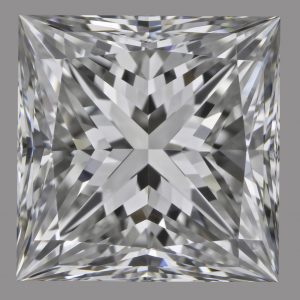Princess Cut Diamonds
Princess cut diamonds come in all diamond colors and clarities. They are the second most popular cut shape for diamonds. Coming second only to the round brilliant cut. Coming in the shape of either square or rectangular. Princess cut diamonds have a profile or side shape that looks like a pyramid with four beveled sides. The princess cut diamond is a new diamond style. The princess cut diamond has become more popular in recent years. This is because of its unique reflective brilliance, similar to that of Round Diamonds. Furthermore, their surge in popularity is because of its distinctive sharp edges. The princess cut is sometimes referred to as a square brilliant.Origins of the Princess Cut
The Princess cut diamond evolved from the "French cut." The French cut features a step-modified "Double-French" or "Cross" cut crown. It also utilizes a variety of chevron-shape facets as its patterns. This gives the princess cut diamond a beautiful and distinct reflection when the diamond is observed directly through the table.Round Diamonds and the Princess Cut Diamond
Princess cut diamonds have sharp edges. The top of a princess cut diamond is the crown. It is cut with a round face-up shape. The princess cut diamond has a bottom that is the pavilion and is the shape of a cone. A princess cut diamond usually has the same width as the diameter of a round brilliant. However, it will weigh more as it has four corners which would otherwise have been cut off. Which is, unlike that of a round diamond. However, while displaying an acceptable output reflection and brilliance, princess cut diamonds have their faceting arranged completely different from that of a round brilliant.The Princess Cut Diamond and Prices
Princess cut diamonds are on average less expensive than round brilliant cut diamonds. The reason why the princess cut diamond of the same carat weight priced against a round diamond is because it retains about 80% of the rough diamond. This is unlike the round brilliant which retains only about 50% of the rough. The ability to retain more crystal weight makes this shape popular amongst diamond cutters. Accredited Gem Appraisers (AGA) and American Gem Society Laboratory (AGSL) and European Gem Laboratories-USA (EGL-USA) are currently the only labs that grade the Princess cut for cut. Measurements vary for a princess cut diamond and many diamond manufacturers market ideal diamonds with differing facet patterns and angles as "ideal cut". In contrast to the AGSL, AGA, and EGL-USA the Gemological Institute of America (GIA) has stated that there is not enough industry consensus or empirical data to specify cut grading standards for Princess cut diamonds and to do so is at the risk of consumers who may be deceived by diamonds accompanied by unqualified Ideal or Excellent cut grades.
Comparing the Princess Cut Diamond
In London 1961, diamond cutter Arpad Nagy designed and dubbed his unique diamond cut as the princess cut, otherwise known as the "Profile Cut." However, the name, princess cut diamond, was is famous by Ygal Perlman, Betzalel Ambar, and Israel Itzkowitz in Israel in 1979. Their diamond cut was similar to that of the original 58 facets of the princess cut, the "Quadrillion." Distribution by diamond company Ambar Diamonds in Los Angeles popularized the name. After extensive research and optic testing, a square stone with faceting similar to that of a round brilliant cut diamond produced. The official name is the square brilliant. It is important to note that the number of chevrons can affect the overall outlook of a princess cut diamond.
Diamond cutters noted that by adding more chevrons on the pavilion side of the diamond. Each individual facet of the diamond breaks down into smaller facets. The result being it can give a princess cut diamond a "crushed ice" look. Conversely, when a princess cut diamond has fewer chevrons, it resembles broader facets.


